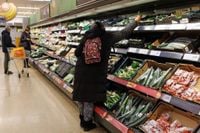Food shopping in the UK has become noticeably more expensive, and for many households, the pinch is sharper than it has been in well over a year. According to the British Retail Consortium (BRC) and NIQ’s Shop Price Monitor, food inflation surged to 4.2% in August 2025, the highest rate in 18 months and up from 4.0% in July. This marks the fastest pace of food price growth since February 2024, and it’s not just a statistical blip—families across the country are feeling it every time they head to the supermarket.
What’s driving this uptick? The sharpest increases have been seen in the prices of everyday staples such as chocolate, butter, and eggs. Helen Dickinson, chief executive of the BRC, summed up the situation: “Staples such as butter and eggs saw significant increases due to high demand, tightening supply and increased labour costs.” The BRC’s latest figures show that fresh food prices jumped to 4.1% from 3.2% the previous month, largely due to higher dairy costs. Meanwhile, ambient food inflation—which covers packaged and long-life goods—slowed slightly, but still sits at a hefty 4.2% year-on-year.
It’s not just food. Overall shop price inflation rose to 0.9% in August, despite a 0.8% fall in non-food goods prices. Official data from the Office for National Statistics (ONS) reveals that inflation hit 3.8% in the year to July, the highest since January 2024. The ONS also highlighted that prices for beef, orange juice, and coffee have seen some of the biggest jumps, with beef and veal prices rising by almost a quarter and coffee up 18% over the past year. Butter and olive oil prices have doubled since 2020—sobering news for anyone who enjoys a full English breakfast or a Mediterranean salad.
Why are these increases happening now? The answer is a complex mix of global and domestic factors. The Bank of England pointed to the April 2025 rise in national insurance contributions as a key driver, compounding the effects of global supply chain challenges and volatile commodity markets. Droughts in Spain, Italy, and Portugal—major suppliers of fresh fruits and vegetables to the UK—have squeezed supply, while increased labour costs and higher demand have added further pressure. As Mike Watkins, head of retailer and business insight at NIQ, explained, “The uptick in prices reflects several factors: global supply costs, seasonal food inflation driven by weather conditions, the conclusion of promotional activity linked to recent sporting events, and a rise in underlying operational costs.”
Retailers aren’t sitting on their hands. Many are expanding price-matching and discounting initiatives to help households cope, but the challenges are mounting. Dickinson noted, “Retailers continue doing everything they can to limit price rises for households, but as the Bank of England acknowledged, the £7bn in new costs flowing through from last year’s Budget has created an uphill battle for retailers.” Energy bills and wage increases are also making it harder to contain inflationary pressures, and the end result is that the weekly shop is hitting wallets harder than ever.
It’s not just the experts who are concerned. More than 60 retail bosses—including leaders at Tesco, Sainsbury’s, and Boots—recently wrote to Chancellor Rachel Reeves, warning that further tax rises in the autumn budget could undermine efforts to ease living costs. The letter, coordinated by the BRC, predicted that food and drink inflation could reach 6% later this year unless some of these pressures are relieved. The bosses made it clear: “Raising taxes further in the autumn budget could contradict plans to improve UK living standards.”
For the government, the surging cost of the weekly shop poses a thorny problem. Prime Minister Keir Starmer has made improving living standards by the end of this parliament a key ambition, but the Resolution Foundation has warned that rising food prices are “particularly concerning for families.” A group of Labour MPs has even set up a new living standards coalition, urging Starmer to do more to address the rising cost of essentials such as food, housing, and energy bills.
With the Bank of England warning that rising food prices are keeping inflation above target, there are fears that hopes for further interest rate cuts could be dashed. It’s a tough balancing act: easing the cost-of-living crisis without adding to inflationary pressures elsewhere in the economy.
So, what can shoppers do to stretch their pounds further? Money-saving experts and consumer advocates have a few practical suggestions. One popular tactic is to look for “yellow sticker deals”—discounted items that are nearing their sell-by dates. According to Richard Price from Britsuperstore, “these stickers usually start appearing around mid-morning, with prices increasingly dropping into the early evening.” Shoppers who time it right can save a significant amount; some have reported saving over £300 a month by snapping up yellow sticker products.
Another option is the Too Good To Go app, which partners with supermarkets, restaurants, and cafes to sell surplus food at reduced prices. Shoppers can buy “surprise bags” of groceries for a fraction of their retail value, though there’s always an element of luck when it comes to what’s inside. More than 160,000 businesses now participate in the scheme, including major supermarkets like Aldi, Morrisons, Asda, Marks & Spencer, and Sainsbury’s.
Consumers are also being encouraged to take the “Downshift Challenge,” which means trading down one brand level on everything you buy—say, from premium to own brand, or from own brand to value range. MoneySavingExpert claims that this approach could save shoppers up to 30% a year on their grocery bills. If you can’t tell the difference in taste or quality, why pay more?
Loyalty schemes and coupons remain a staple of the British supermarket experience. According to the Competition and Markets Authority, 97% of shoppers are members of at least one supermarket loyalty scheme, and most belong to three. Points, discounts, and cashback offers can add up, especially if you’re savvy about when and where you use them.
Finally, simply switching supermarkets can yield big savings. Discount retailers like Aldi and Lidl have been recognized for their lower prices, with Which? recently naming Lidl the UK’s cheapest supermarket. Their analysis found that shopping at Lidl instead of Waitrose could save a household up to 25% on their monthly grocery bill—a figure that could make a real difference for families feeling the squeeze.
As the UK heads into autumn, the latest figures suggest that food shopping will remain one of the most acute pinch points in the cost-of-living crisis. With global and domestic pressures still swirling, and government policy in the spotlight, households will need to stay alert, creative, and resourceful to keep their food bills in check.


